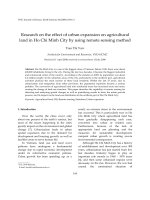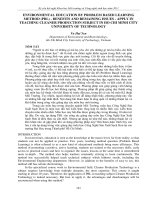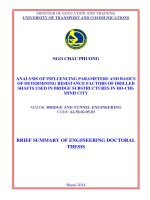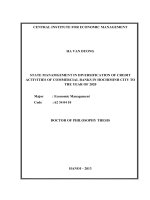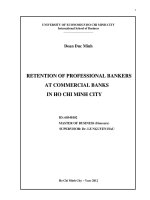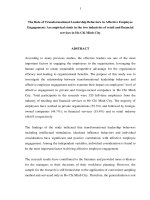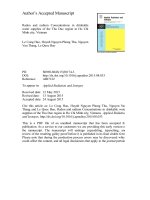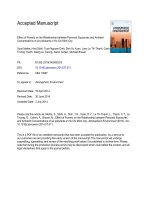The use of cognitive and meta cognitive views in teaching reading for second year english majors in ho chi minh city open university obstacles and solutions
Bạn đang xem bản rút gọn của tài liệu. Xem và tải ngay bản đầy đủ của tài liệu tại đây (2.82 MB, 50 trang )
BỘ GIÁO DỤC VÀ ĐÀO TẠO
TRƯỜNG ĐẠI HỌC MỞ THÀNH PHỐ HỒ CHÍ MINH
-------- ∞0∞--------
PHẠM ĐƠNG QN
THE USE OF COGNITIVE AND
META-COGNITIVE VIEWS IN TEACHING
READING FOR SECOND-YEAR ENGLISH
MAJORS IN HCM CITY OPEN UNIVERSITYOBSTACLES AND SOLUTIONS
KHĨA LUẬN TỐT NGHIỆP
NGÀNH NGƠN NGỮ ANH
TP. HỒ CHÍ MINH, NĂM 2020
1
BỘ GIÁO DỤC VÀ ĐÀO TẠO
TRƯỜNG ĐẠI HỌC MỞ THÀNH PHỐ HỒ CHÍ MINH
-------- ∞0∞--------
PHẠM ĐƠNG QN
THE USE OF COGNITIVE AND
META-COGNITIVE VIEWS IN TEACHING
READING FOR SECOND-YEAR ENGLISH
MAJORS IN HCM CITY OPEN UNIVERSITYOBSTACLES AND SOLUTIONS
Mã số sinh viên: 1557010192
KHÓA LUẬN TỐT NGHIỆP
NGÀNH NGÔN NGỮ ANH
Giảng viên hướng dẫn: ThS. BÙI ĐỖ CƠNG THÀNH
TP. HỒ CHÍ MINH, NĂM 2020
2
TRƯỜNG ĐẠI HỌC MỞ
THÀNH PHỐ HỒ CHÍ MINH
KHOA NGOẠI NGỮ
CỘNG HÒA XÃ HỘI CHỦ NGHĨAVIỆT NAM
Độc lập – Tự do – Hạnh phúc
GIẤY XÁC NHẬN
Tôi tên là : Phạm Đông Quân
Ngày sinh: 11/10/1997
Nơi sinh: TP.HCM
Chuyên ngành: Ngôn ngữ Anh
Mã học viên: 1557010192
Tơi đồng ý cung cấp tồn văn thơng tin khóa luận tốt nghiệp hợp lệ về bản quyền cho Thư
viện trường đại học Mở Thành phố Hồ Chí Minh. Thư viện trường đại học Mở Thành phố
Hồ Chí Minh sẽ kết nối tồn văn thơng tin khóa luận tốt nghiệp vào hệ thống thông tin
khoa học của Sở Khoa học và Cơng nghệ Thành phố Hồ Chí Minh.
Ký tên
(Ghi rõ họ và tên)
Phạm Đông Quân
Ý KIẾN CHO PHÉP BẢO VỆ KHÓA LUẬN TỐT NGHIỆP
CỦA GIẢNG VIÊN HƯỚNG DẪN
Giảng viên hướng dẫn: ThS. Bùi Đỗ Công Thành
Học viên thực hiện: Phạm Đông Quân
Lớp: DH15AV04
Ngày sinh: 11/10/1997
Nơi sinh: TP.HCM
Tên đề tài: “The use of cognitive and meta-cognitive views in teaching reading for
second-year English majors in HCM city Open University – Obstacles and Solutions”
Ý kiến của giáo viên hướng dẫn về việc cho phép học viên được bảo vệ khóa luận trước
Hội đồng: ...................................................................................................................................
.....................................................................................................................................................
.....................................................................................................................................................
.....................................................................................................................................................
.....................................................................................................................................................
.....................................................................................................................................................
.....................................................................................................................................................
.....................................................................................................................................................
.....................................................................................................................................................
.....................................................................................................................................................
Thành phố Hồ Chí Minh, ngày .....tháng.......năm..............
Người nhận xét
.................................................
ACKNOWLEDGEMENTS
Firstly, I would like to express my gratitude towards my mentor, M.Ed. Bui Do
Cong Thanh. But for his guidance and support, I would have found it almost impossible to
conduct this graduation paper. Moreover, many thanks are given to my family for their
unconditional love and sacrifice that truly encouraged me to make greater attempts in the
completion of the thesis. Also, I would like to acknowledge and appreciate the active
participation of not only the students but also the lecturer in the survey, thanks to which I
could collect critical and useful data for analysis and interpretation. Such contribution has
paved the way for my enlightenment in the instructions of reading comprehension at
tertiary education. Finally, I would like send my sincere thanks to the Faculty of Foreign
Languages of Ho Chi Minh City Open University, particularly all of the lecturers of
English for providing me with an unparalleled opportunity to conduct this graduation
paper.
iii
STATEMENT OF AUTHORSHIP
I certify that the thesis entitled “The utilization of cognitive and meta-cognitive views to
teach reading skills to second-year English majors at HCM city Open University –
obstacles and solutions” is my own work.
Except where reference is made in the text of the thesis, this thesis does not contain
materials published elsewhere or extracted in whole or in part from a thesis by which I
have qualified for or been awarded another degree or diploma.
No other person’s work has been used without due acknowledgement in the main text of
the thesis.
This thesis has not been submitted for the award of any degree or diploma in any other
tertiary institution.
Ho Chi Minh City, August 2020
Pham Dong Quan
ii
SUPERVISOR’S REMARKS
I hereby certify to the best of my knowledge that:
the research and the writing embodied in the thesis are that of the candidate except
where due reference is made in the text
the candidate demonstrated his strong commitment to meeting the supervisor’s
fundamental requirements during the implementational process of the thesis
the language use in the entire thesis is academic and thus being appropriate for the
BA thesis
the findings are significant and greatly contribute to the problem solving of the
existing issues.
From the above-stated, the thesis is properly presented and worthy of consideration forthe
thesis defence.
Signature
Date
iv
ABBREVIATIONS
HCMC OU: Ho Chi Minh City Open University
IELTS: International English Language Testing System
FFL: Faculty of Foreign Languages
L1: The first language
L2: The target language
ESL: English as a Second Language
EFL: English as a Foreign Language
v
ABSTRACT
The aim of this paper is to delve deeper into reading comprehension problems that secondyear English majors encounter and propose some practical solutions for these problems in
HOU context. The data of this study is collected through the questionnaire and interview.
100 second-year English majors took part in answering the questionnaire to give a
snapshot about their reading problems in practice. An experienced teacher in teaching
reading comprehension is interviewed to unveil the obstacles in teaching reading skills and
suggest some solutions to such problems. The data from the questionnaire and the
interview indicates that the main obstacle for students to comprehend a text is the lack of
vocabulary and the lack of prior-knowledge, and those for teachers to apply cognitive and
meta-cognitive is different learners’ needs. Also, these findings indicate the activating and
building prior knowledge gives the students a reason to read. Therefore, integrated and
content-based teaching methods should be considered as remedial action against students’
reading comprehension problems.
Key words: cognitive views, meta-cognitive views, prior knowledge, reading
comprehension, traditional views
vi
TABLE OF CONTENT
ACKNOWLEDGEMENTS................................................................................... III
SUPERVISOR’S REMARKS ............................................................................... IV
ABSTRACT ............................................................................................................ VI
TABLE OF CONTENT ........................................................................................VII
CHAPTER 1: INTRODUCTION ............................................................................ 1
1.1.
Background of the study............................................................................................................... 1
1.2.
Problem statements ...................................................................................................................... 2
1.3.
Research Aims .............................................................................................................................. 3
1.4.
Research Questions....................................................................................................................... 3
1.5.
Research Significance ................................................................................................................... 3
1.6.
Overview ....................................................................................................................................... 4
CHAPTER 2: LITERATURE REVIEW ................................................................ 5
2.1.
Views of reading ........................................................................................................................... 5
2.1.1.
Traditional view........................................................................................................................... 5
2.1.2.
Cognitive views ............................................................................................................................ 6
2.1.3.
Meta-cognitive view..................................................................................................................... 9
2.2.
Obstacles in utilizing cognitive and meta-cognitive views in EFL reading classes .....................10
2.3.
Guideline for teachers to enhance student’s reading comprehension.........................................11
2.3.1.
Pre-reading strategies ............................................................................................................... 11
2.3.2.
While-reading strategies ........................................................................................................... 12
2.3.3.
Post-reading strategies .............................................................................................................. 13
CHAPTER 3: METHODOLOGY ......................................................................... 16
3.1. Research design .................................................................................................................................16
3.2. Research setting .................................................................................................................................16
3.3. Participants........................................................................................................................................17
vii
3.4. Data collection process ......................................................................................................................17
CHAPTER 4: DATA ANLYSIS AND INTERPRETATION ............................. 18
4.1.1. The views of reading .......................................................................................................................... 19
4.1.2. Obstacle in utilizing cognitive and meta-cognitive views in EFL reading classes ............................ 21
4.1.3. Guideline for teachers to enhance student’s reading comprehension ............................................... 24
4.2. Data from interview ..........................................................................................................................26
4.3. Discussion ..........................................................................................................................................27
CHAPTER 5: CONCLUSION OF THE STUDY ................................................ 29
5.1. Conclusion .........................................................................................................................................29
5.2. Recommendation ...............................................................................................................................29
5.3. Research Limitations .........................................................................................................................30
5.4. Suggestions ........................................................................................................................................30
REFERENCES .......................................................................................................... 1
Appendix A: Questionnaire ...................................................................................................................... 1
Appendix B: Interview questions .............................................................................................................. 5
Appendix C: Interview transcript............................................................................................................. 6
viii
CHAPTER 1: INTRODUCTION
This chapter provides a brief description of the background of the study, problem
statements, research aims, research questions, research significance, research limitations,
and the overview.
1.1.
Background of the study
Innovations in science and technology in the twenty-first century have brought about
astounding changes to people’s life, enabling them to make more progress in their personal
and professional life. It is apparent that the acquisition of the latest innovations taking
place in this constantly changing world has become a necessity for everyone. To make
effective use of these innovations, there is a need for a common language for everyone to
communicate with one another worldwide. Over the years, English has proven to be an
indispensable tool used for communication as proved in various research (Rao, 2019).
According to Hammond(2019), although Chinese is the most spoken language by native
speakers, English has become the global language with about 1,121 billion speakers
including native and non-native speakers. Indeed, having such a global language, a person
can pursue a higher career path as well as optimize the opportunity to enrich his
experience, knowledge and build good relationship with experts in his field. Seeing this
great benefit, the government has put much effort to enhance English teaching in the
country. For instance, the EF English Proficiency Index mentioned that over 380 million
USD was planned to invest in teacher training by the government (TuoiTre News, 2014),
this created a stimulating and rewarding environment for teachers to harness their teaching
skills. However, the article also stated that although teachers and learners focused on
reading and vocabulary, students are only taught how to deal with reading questions rather
than how to understand the ideas of the author. This has brought to the meta-cognitive
views, which is associated with top-down process, and the key role of prior-knowledge
(Smith, 1994). Recent findings have also emphasized the significant role of pre-knowledge
in understanding a text rather than reading skills.
Results in the research of Ozuru,
Demsey, & McNamara (2009) indicated that general comprehension has a mutual
relationship with students’ prior knowledge. Furthermore, what students had known before
positively affected the contribution of working memory to L2 reading comprehension(Joh
& Plakans, 2017). Besides, prior-knowledge activation method resulted in better reading
1
comprehension, metacognitive and inference-making processes(Tarchi, 2015). Lastly,
prior-knowledge both directly and indirectly influences reading comprehension through the
mediation of inferences(Tarchi, 2010). Moreover, only prior-knowledge cannot help the
students to accquire new information they read, so meta-cognitive view is created for such
purpose. Block (1992) decribed the view as different stages executed by reader in order to
understand a text, such as assesing, evaluating, planning, and reflecting.
1.2.
Problem statements
Although there has been much evidence of the significance of cognitive views and metacognitive view in reading, it is hardly put into practice in the teaching of reading in
Vietnamese schools. This leads to the fact that despite passing reading tests with flying
colours, Vietnamese students still struggle to comprehend a text written by a native writer
such as articles on newspapers or even books and research journals. Nevertheless,
universities, especially foreign faculties have tried to adjust their teaching curriculum as a
solution to that problem. Therefore, besides learning skills to pass reading exams, students
are taught how to actually comprehend a text. Hence, reading is considered as a crucial
skill to acquire the target language and culture, and research into this field should be
carried out more regularly and carefully.
Language has long been the author’s passion inspired by his very first teacher. Becoming
an English major has provided him with a favorable condition to deeply understand such a
global language. Specifically, he has learned how the language and culture are shaped and
intertwined. Witnessing the obstacles and drawbacks of teaching English, especially in
reading, in secondary and high school in Vietnam, I have a determination to become an
English teacher. As an English major, he has experienced some difficulties in learning
reading skills. First, it is obvious that one of the reasons for the difficulty in learning
reading is that teachers themselves have to struggle to teach them. Second, even when
students are able to acquire them, they cannot apply it in the tests at school. Third, students
just learn reading skills because they must pass the end of course test. Fourth, the texts in
tests require the combination of different skills to solve it, which is not taught before, or
the students have almost no idea about the topic of the texts. Learning teaching
methodology has given me a marvelous opportunity to further investigate the problems that
teachers encounter while teaching reading skills. Due to the aforementioned, language
teaching has been regarded as his major field in this research and priority is given to the
2
topic “The utilization of cognitive and meta-cognitive views to teach reading skills to
second-year English majors at HCM City Open University – Obstacles and solutions”.
Since little research about the topic has been done, the author is motivated in doing this in
order to find an effective and practical solution to the teaching of reading comprehension at
HOU.
1.3.
Research Aims
This thesis aims to evaluate the problems that lecturers at HOU face when teaching reading
skills as well as to propose possible solutions.
1.4.
Research Questions
According to abovementioned problems, this graduation paper is conducted to answer the
following questions.
1. What obstacles do HCMCOU lecturers encounter when teaching reading skills to
second-year English majors?
2. What can be an effective guideline for teaching reading skills to HCMCOU
sophomores?
1.5.
Research Significance
This research is conducted with the aim of investigating obstacles that lectures encounter
when teaching reading skills at HCMCOU. Therefore, it will benefit both lecturers and
English majors in the Faculty of Foreign Languages.
Based on the findings of this study, lecturer may have a deeper insight of the problem
students have when learning reading. They can adapt their lesson plans by developing
suitable aims for each lesson in light of the level of their classes. Moreover, they can find
useful ways to avoid hindrance in building students’ knowledge and pondering the
implications of this paper for their reading classes.
Finally, in terms of the English majors, they are properly guided and become more active
in their practice of reading skills. By deeply understanding the nature of reading, the
pivotal role of background knowledge in learning reading skills, they can identify their
own needs and develop their own learning strategy in order to acquire reading skills and
comprehend authentic written materials such as books, magazines, and other genres.
3
1.6.
Overview
The thesis is composed of five chapters.
Chapter 1 provides some information about the background of this study and states the
problems together with the research aim and two research questions.
Chapter 2 is the review of literature in which the theoretical knowledge about the views of
reading and obstacles for applying those views in teaching reading skills are discussed.
Chapter 3 introduces the methodology of this study and clearly states the research setting,
participants, design, and data collection process.
Chapter 4 places an emphasis on analyzing the data collected previously as well as
discusses the findings drawn from the collected data.
Chapter 5 summarizes the main findings of the study and offers some recommendations as
well as suggestions for further studies.
4
CHAPTER 2: LITERATURE REVIEW
This chapter encompasses three views of reading: traditional, cognitive, and metacognitive views along with their implications in teaching reading in HCMCOU’s context.
There are obstacles in utilizing cognitive and meta-cognitive views which will be carefully
discussed and an effective guideline will be proposed to solve these problems.
2.1.
Views of reading
There has been a shift in not only teaching methodology but also reading theories. They are
enhanced from the traditional view focusing on the form of the text to the cognitive view
which highlights the role of background knowledge, and they culminated in the metacognitive view, which is now in vogue. It is based on readers’ ability to control and
manipulate the text when comprehending it (Vaezi, 2006).
2.1.1. Traditional view
It was widely claimed by behaviorist psychology of the 1950s that learning was based on
habit formation, a consequence of repeated association of a stimulus with a response. As a
consequence, language learning is described as persisting language patterned reinforced by
the community of language users(Hadley, 1993). According to this view, reading is a
“linear process” by which readers decode a text word by word and put these words
together to form phrases and sentences (Gray and Rogers, cited in Kucer, 1987). However,
this belief was heavily criticized by Samuels and Kamil (1988). They claimed that reading
was treated as recognition process responding to the stimuli of the printed words, where
there was little explanation for what went on within the recesses of the mind allowing
human to make sense of the printed page. In other words, readers can comprehend the text
by adding meaning of words to get the meaning of clauses and sentences. This process had
a great emphasis on recognizing and recalling. Thus, in traditional view, reading is
considered as a set of hierarchically ordered sub-skills, and having mastered these skills,
readers are viewed as experts who comprehend what they read. (Dole et al., 1991).
Today, the main method associated with the bottom-up approach to reading is known as
‘asphonics’, which requires learners to match letters with sounds in a defined sequence
(Pardede, 2008). Like the audio-lingual teaching method, phonics emphasizes repetition
and drills using the sounds that make up words. Learners will receive and process the
information from the smallest sound units, and proceeded to letter blends, words, phrases,
and sentences. Thus, novice readers acquire “a set of hierarchically ordered sub-skills” that
5
sequentially build toward comprehension ability. The bottom-up model considers
information flow as a series of stages transforming the input and passing it to the next stage
without any feedback or possibility of later stages of the process influencing earlier stages
(Stanovich, 1980). Therefore, readers are considered as passive recipients of the
information in the texts and they have to reproduce the meaning resided in them.
Consequently, the ESL and EFL books influenced by this model only focus on literal
comprehension, recalling lexical and grammatical forms, and decoding aspects.
This model of reading has almost always been under attack as being insufficient and
defective because it relies on the formal features of the language, mainly words and
structures (Vaezi, 2006). Although this view of reading is rejected since it is over-reliance
on the structure or form of the language, it is undeniable that knowledge of linguistic
features is also necessary for reading comprehension to some extent.
2.1.2. Cognitive views
In 1960s, a dramatic shift occurred in the cognitive sciences (Pardede, 2008). The new
cognitive theory, which represented the mind’s innate capacity for learning and gave a new
way to explore how human required their first language, has led to the discredit of
behaviorism. The new theory has provided such an advanced way to explain how human
acquire their first language, resulting in a tremendous impact on the field of ESL/EFL. This
explained “how such how such internal representations of the foreign language develop
within the learner’s mind” (Hadley, 1993, p. 57).
Meaningful study and rote learning hav been distinguished by Ausubel (as cited inHadley,
1993). An example of rote learning is to memorize lists of isolated words and rules in the
new language. Learning by this way, the information acquired is stored in short-term
memory and gradually lose without revision. In contrast, when new information is put in a
specific context connecting with what learners have already known, meaningful learning
occurs. The information can be easily integrated into one’s existing knowledge and
becomes permanent. This emphasis on meaning eventually formed the top-down approach
in L2 learning and led to the explosion of teaching methods and activities whichinvolved
learners’ experience and knowledge in 1960s and 1970s.
These new cognitive and top-down approaches have dramatically changed the way
students learn to read(Smith, 1994). In this view, reading is not just separating meaning
from the text but associating information in the text with learners’ existing one. Moreover,
reading is a dialogue between readers and the text, in which the creation of meaning is
formed by readers’ background knowledge (Tierney & Pearson, 1981). That is to say,
6
reading is not a passive mechanical activity but an active cognitive process heavily
dependent on the prior knowledge and expectation of readers. In support of this view,
Goodman (as cited in Paran, 1996) described reading as a linguistic guessing game of the
brain, a process in which readers sample the text, make hypotheses, confirm or reject them,
and formulate new ones.
2.1.2.1.
Schema Theory
Another theory having a major impact on reading instruction and closely related to topdown process is schema theory. It illustrates in detail how learners’ background knowledge
is associated with the reading task and gives a snapshot about how students’ previous
experience is significant to the interpretation of the text. The ability to use schemata,
background knowledge, plays a key role in their efforts to comprehend the text.
Schema theory is based on the principle that past experience leads to the creation of
“mental frameworks” that help learners make sense of new experience. Smith (1994)
defined schemes as the extensive representations of more general patterns or regularities
that occur in our experience. For instance one’s generic scheme of a bus will allow him to
define and imagine the bus although he has not been on one before. This means that past
experience will foster new experiences, which may involve the knowledge of objects,
situations, and events as well as that of the procedures for retrieving, organizing and
interpreting information. In Anderson’s research (2018), he highlighted that readers’
schemata significantly affects their comprehension. He explained that they can understand
the message conveyed in the test when they can recall a schema that provides the detail or
explanation of the objects and events described. In other words, comprehension is the
process of “activating or constructing a schema that provides a coherent explanation of
objects and events mentioned in a discourse” (Anderson, 2018). Anderson and Pearson
(1988) strongly believed that comprehension was the interaction between old and new
information, in which new information was modified by old ones. Therefore, new
information will be added to their schemata, a network that restructures itself to
accommodate new information (Hadley, 1993).
Schemata is divided into formal schemata (knowledge about the structure of a text) and
content schemata (knowledge about the subject matter of a text), and they will allow
readers to predict events and deduce meaning from a wide context. Formal schemata will
allow learners to identify how texts differ from one another. For instance, learners can see
the difference in structure between a fiction work and a research essay. According to Smith
(1994), knowing the genre of the text will significantly contribute to learners’
7
comprehension since it provides them with a basis for predicting what a text will be like.
Thus, teaching formal schemata will bring a huge benefit for learners to help them
comprehend what they read better. In comparison, content schemata refers to the message
conveyed in the text. Additionally, as Anderson (2018) explained readers can understand
the message when they are able to recall a schema that provides details about the objects
and events described in the message. Accordingly, their familiarity with the content will
make it more productive and efficient for them to grasp the precise meaning of the text.
2.1.2.2.
Activating and building schemata
Since learners play a key role in this view, their age, gender, experience, and culture will
affect the text selection. A text with appropriate level will not only make it easy for
learners to understand, but also motivate them in reading it. Anderson (2018) noted that
when readers cannot bring to mind a schema that fits a text, they may find it
incomprehensible. There are many cases that learners do not have a schema that is
important for the text and cannot activate relevant schema to understand the text. In such
cases, teachers need to be ready to engage in building new background knowledge as well
as activating existing one(Carrell, 1984). That is to say, teachers can help students to
merge isolated “parcels” of knowledge into a schema or to build a new one (Bransford,
1994). This is referred by Bransford (1994) as the integrated model, in which students
combine different skills to merge new information with the old one.
McDonough (1995) claimed that if the context of the text involves cultural aspects
different from students’, formal and content schemata become even more important. He
also explained that due to the lack of culture background knowledge, learners may
misunderstand the events mentioned in the reading text. Therefore the teachers’ role in
building and activating schemata is highlighted.
2.1.2.3.
Applying schema theory to L2 reading
In order to teach reading effectively, teachers should select the text appropriate to learners’
needs, preferences, individual differences, and cultural aspects. It will enable students to
comprehend the text as well as activate existing schemata and build new ones.
Subsequently, they need to do the following three stages: pre-reading activities, whilereading activities, and post-reading activities (Pardede, 2008).
In the first stage, students have to think, write, and discuss everything they have known
about the topic through some of the techniques like prediction, semantic mapping, and
reconciled reading. The objective in this stage is to ensure that students have relevant
schemata to understand the text. In the second stage, students’ interaction with the text will
8
be observed carefully. Teachers can teach students skills such as note-taking, which allows
them to organize new vocabulary and important details, and summarize the formation in
the text. In the final stage, activities will consolidate the knowledge they gain through the
text. Accordingly, they will be given a chance to reproduce the language and apply it into
their daily conversation. Although schema activation and building can occur in all the
stages, the pre-reading stage is crucial since it provides initial impression and contact of
learners and the text (Pardede, 2008).
2.1.2.4.
Pre-reading stage
Pre-reading stage is the main stage where schema theory is applied in reading. The main
aim of this stage is to recall what students have known about the topic of the text; and all
the activities are defined as means for bridging the gaps between the text’s content and
learner’s schemata (Chen & Graves, 1995). Key vocabulary can be introduced by various
activities which reinforce concept association to activate both formal and content
schemata. While activities such as organizing and reading for main ideas are frequently
used to activate formal schemata, brainstorming and predicting the events in a text are
highly recommended for building content schemata. According to Goodman (1998),
prediction is indispensable since the brain is continuously anticipating and predicting while
seeking order and significance in sensory input. Smith (1994) defines prediction as the
questions readers ask, and comprehension is deducing the meaning from the text. He
strongly believed that it is the prediction that helps readers to become more effective in
reading texts which contain familiar subject matters. Smith (1994) pointed out that
prediction brings possible meanings to the text, lower ambiguity and exclude irrelevant
alternatives. Therefore, learners can generate comprehensible experience from the text.
2.1.3. Meta-cognitive view
Block (1992) declared that it was meaningless to debate whether reading is “languagebased” process or “knowledge-based” process since research has gone further to define
“the control executed by readers on their trial to understand a text”. This control has been
referred by Block as “meta-cognition”.
In terms of reading, meta-cognition means monitoring what one is doing while reading
(Pardede, 2008). Not only do strategic readers examine the text, agree or reject hypothesis
they have made during reading, but they also involve many activities along reading stages
which have been divided into three - pre-reading, while-reading, and post-reading stage.
What readers do in the first stage is to identify the purpose of reading and form or type of
the text. In the second stage, general features and details of the text are carefully examined
9
in order to get the meaning of the whole text. Readers can read the topic sentence to get the
general meaning and supporting details for more specific information. Subsequently, they
can predict what might happen next in the text by combining prior-knowledge of the topic
and the information received in the previous paragraph. In the last stage, readers can make
a conclusion and a summary about the text or they can do some tasks to fully exploit the
text.
2.2.
Obstacles in utilizing cognitive and meta-cognitive views in EFL reading
classes
Wexler (2019) has stated that there have been widespread problems with training in
comprehension instructions. While the effectiveness of systematic phonics in helping
children to decode the written language, quite a few teachers have claimed that they were
given this information in their training. Also, she pointed out that teacher training courses
are more likely to include reading comprehension. However, what potential teachers learnt
in those courses is “dangerously inaccurate”. One of the reasons is the influential 2001
report of the National Reading Panel, which proposed the “five pillars” of reading
instruction, including phonics, phonemic awareness, fluency, vocabulary, and strategies
designed to boost comprehension. However, she pointed out that the comprehension
strategies endorsed by the panel are only achieved when learner’s prior knowledge is
adequate to understand the text in the first place.
In a typical comprehension lesson, teachers focus on supposed skills or strategies such as
answering eliciting questions or recognizing the author’s attitude. She declared that
teaching those skills is like pressing the elevator button twice: it may make people feel
safer but does not make the elevator go faster. Even when teachers try to imply strategies
supported by research, they do not do it properly in the way it proposed. Instead of
providing a difficult text first and modeling strategies to exact its meaning, they put a
strategy in foreground and choose a simple text to demonstrate how the skill works,
without paying attention to its topic. Studies have shown that students stop getting benefits
after only two weeks of strategy instruction (Wexler, 2019).
After being explained a “comprehension skill”, students start practicing it on books which
are easy enough for them to read on their own or with little help. However, there has been
no evidence that graded texts boost comprehension, and studies have found that students
learn more from texts above their level with enough support from the teachers (Wexler,
2019). Indeed, leveled reading has little contribution to building knowledge process, which
requires staying on the same topic for several weeks. As mentioned, due to the reading
10
texts teachers use to demonstrate a “comprehension skill”, the books students use to
practice are not organized by topics.
Another spreading and dangerous misconception is the delusion that students need to
“learn to read” before they can “read to learn” (Wexler, 2019). This results in high-stakes
tests in reading through not only in elementary but also in middle-school curriculum.
Moreover, this belief ignores the fact that that gaining knowledge is part of learning to
read. Even while students are learning to decode, they can take in far more sophisticated
concepts and language by listening to them than by reading on them own. If students are
not provided text-relevant knowledge and vocabulary, they will fail to understand the text
when they decode it by themselves. Furthermore, the hesitation in building students’
knowledge widens the gap between those lucky enough to gain knowledge outside the
school and their less fortunate peers (Wexler, 2019).
2.3.
Guideline for teachers to enhance student’s reading comprehension
After much discussion related to concepts and precepts has been made in the three reading
theories, it is important to arrange tips to make a good guideline to enhance learners’
reading abilities. The following tips are arranged in three reading stages: pre-reading,
while-reading, post-reading. Pardede, P. (2008) has proposed a guideline for effective
teaching of reading, which will be under scrutiny in relation to its implication in the
HCMCOU context.
2.3.1. Pre-reading strategies
In the earliest stage of reading, activities are designed to make the text easily
comprehensible. First of all, teachers should make sure that the level of the text is
associated with learners’ level and its topic should be in correspondence with learners’
needs. Then, teachers should prepare learners with necessary background knowledge to get
them familiar with the topic and the text. This could be done through letting learners
brainstorm ideas and discuss what they have known about the topic with their peers.
Finally, teachers should ensure that the text mostly contains familiar vocabulary and
grammar points with learners. Should there be any new words or unlearnt grammatical
points, it is the teacher’s responsibility to provide them for learners.
There are some activities which might be very useful in helping the students to overcome
the fear to read the text as soon as they receive it.
Teacher-directed pre-reading activities
11
In these activities, the teacher directly provides key concepts and vocabulary for learners.
The types of text are also introduced to the learners since its importance. Each text layout
has a different way to display information. Therefore, by knowing the layout, students can
easily find necessary information for comprehension. Such familiarity will significantly
contribute to the speed of the learner’s comprehension; in other words, they will be able to
understand the text more deeply and read it faster. Even by looking at the publication date
and the author, students may make their own prediction of the layout and content of the
text.
Interactive activities
As it is known, discussion is one of the best methods to activate the prior-knowledge. The
teacher can lead a discussion on the topic of the text to combine their prior-knowledge and
new knowledge needed to understand the text. Furthermore, explicit links between
important information in the text and learners’ prior-knowledge can be made during the
procedure.
Reflective activities
It is important for students to be aware of the reason to read the text. They can be guided to
have their own reason to read. The guidance can be given to young learners from the
beginning in order to develop a habit of having a reason to read. For example, student can
be guided to ask themselves questions such as Why am I reading this text? What do I know
or what can I do after reading this text? Such questions can help learners determine what
skills they need to use to understand the text (skimming, scanning, reading for gist, reading
for details, critical think0ing, and so forth).
2.3.2. While-reading strategies
While-reading stage is where the most students’ comprehension of the text happened. In
this stage, students may adopt a flexible approach & vary reading strategies according to
the type of reading materials & purposes for reading. Therefore, the teacher plays an
important role in helping the students to develop their skills. The followings may be
effective in encouraging active reading which does not heavily depend on the dictionary.
Anticipating (expect) & predicting what will come next in the text
Not only do the students make prediction about what might happen in the text according to
the topic, but they also guess what happens next while they are reading it. It would be great
if they know how to use the previous information in the text to make prediction while they
are reading.
12
Deducing the meaning of words by understanding word formation and contextual
clues
It is unnecessary for students to know the meaning of every word in the text. Instead,
breaking unfamiliar words into smaller parts such as affixes and bases might help the
students to get the meaning of the words and keep the process of comprehension
ongoing.
Identifying the main idea & other salient (important/noticeable) features
Knowing the main idea of not only the text but also that of component paragraphs
might help students to locate the explicitly stated information. Moreover,
understanding salient features also helps students to get the main idea of the text and
understand how the information is organized.
Integrating prior knowledge
The schemata that have been activated in pre-reading stage can be used to facilitate
students’ reading comprehension.
Skipping insignificant parts
Students should be taught to concentrate on important pieces of information and skip the
unimportant ones.
Reading in chunks
By reading groups of words together, students can ensure their reading speed. This can
improve their comprehension by focusing on groups of meaning-conveying symbols at the
same time.
Pausing
Students should be taught to pause at important places while reading to digest and sort out
the information they have received.
Paraphrasing
While reading the text, students can paraphrase or interpret “sub vocally” to verify the
information comprehended.
Monitoring
Students should always ask whether reading and understanding the text has met their need
or not.
2.3.3. Post-reading strategies
Post-reading activities basically depend on the main aim and subsidiary aim of the lesson.
Post-reading activity is to first check students’ comprehension and then guide them to
13
further analysis of it (Barnett, 1988). He also pointed out that second language reading
must go beyond memorizing the author’s point of view or summarizing the text content
due to the goal of integrating new information with the already existed one. Students must
be flexible in adopting variety reading strategies. For example, scanning might be suitable
for newspaper advertisements whereas predicting might be suitable for short stories. He
has proved that group discussion provides a great opportunity for students to focus on
information they did not comprehend or comprehended incorrectly.
Furthermore, Philips (1985) claimed that “follow-up” exercises can benefit learners by
either transferring reading skills to other texts or integrating reading skills with other
language skills. Transferable reading strategies are those that readers can embrace and use
with other texts.
Post reading usually involves these activities: discussing the text: written/oral,
summarizing:
written/oral,
making questions:
written/oral,
answering
questions:
written/oral, filling in forms and charts, writing reading logs, completing a text, listening to
or reading other related materials, and role-playing.
To sum up, in traditional view of reading, a good reader is supposed to acquire all of
hierarchy set of reading skills. Nevertheless, the cognitive and meta-cognitive emphasize
learners’ prior knowledge rather than focus on “comprehension skills”. Still, there are
some obstacles faced by the teachers in utilizing them in teaching reading:
Paying less attention to phonics instructions
Putting “comprehension skills” in foreground instead of difficult texts
Choosing leveled reading texts which are not very useful in boosting learners’
comprehension
The topics of practice texts are not categorized
Misconception of learning to read before “read to learn”
High-stakes tests
Hesitation in building learners’ knowledge
Big gap between learners acquiring knowledge outside school and those who do not
Therefore, it is pivotal for teacher to make use of students’ prior knowledge generate
general context which greatly contributes to their reading comprehension. The role of
cognitive and meta-cognitive views is highlighted by its wide application in preparing
reading lesson plans. The views usually appeared in the form of three-stage process: prereading, while-reading, post-reading. The significant role of activating prior-knowledge of
14

